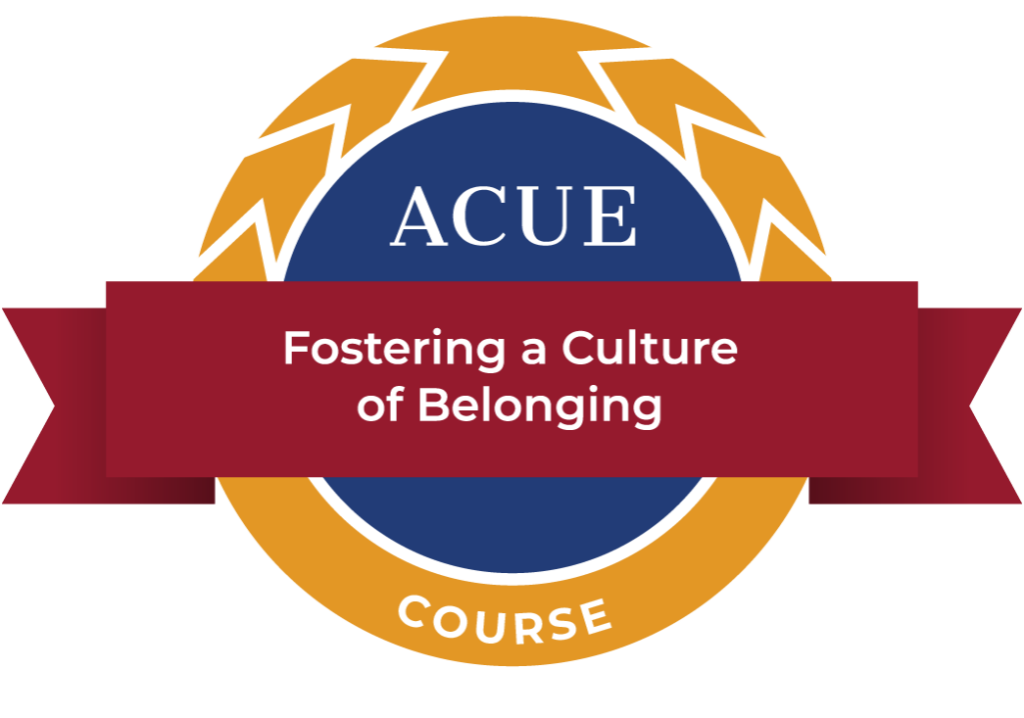
Fostering a Culture of Belonging: How Mutual Respect and Collaboration Led to Faculty Productivity and Student Success
Belonging is the feeling of connection, respect, acceptance, support, and inclusion that students or employees experience in their school or work environment (Arslan, 2021; Baumeister & Leary, 1995).
I was excited to cofacilitate the Fostering a Culture of Belonging (FCB) course after helping two faculty cohorts successfully complete ACUE’s Effective Teaching Practices course.
I knew that the course content would be relevant for all employees because the course addresses critical issues such as implicit bias, microaggression, imposter syndrome, and inclusivity, all which impact both student success and employee productivity and retention.

Empowering Belonging Through Collaborative Initiatives
Now that the cohort has successfully completed the FCB course, I have had the opportunity to reflect on what I learned from the course material and from the biweekly cohort meetings.
Like others in the cohort, I have experienced bias, microaggressions, and inequitable treatment at various times during my 16-year tenure at the institution–experiences that left me feeling unappreciated and disconnected from colleagues. But I want to share an experience that embodies many of the research-based practices discussed in the FCB course on how to ensure colleagues feel seen, heard, and valued, thereby fostering a sense of belonging.

My junior colleague, Assistant Professor Harsh Patel, had been considering a redesign of the introductory statistics course for several years.
Last year, Professor Patel shared his idea with my senior colleague, Dr. Anita Polk-Conley. She encouraged him to apply for a new grant that offered faculty the opportunity to complete a redesign using Open Educational Resources (OER).
The two colleagues decided to partner and requested information for completing the grant together. Once they received the grant information, Dr. Polk-Conley reached out to share the information with me. My two colleagues had both taught introductory statistics for many years.
They each had their own unique approach to instruction, and Dr. Polk-Conley had previous experience successfully writing grants. It is important to note that Dr. Polk-Conley and Professor Patel did not need me to join them on this journey, but they wanted me to be a part of their team.
I politely declined when Dr. Polk-Conley extended an invitation to join her and Professor Patel in their endeavor to redesign the introductory statistics course. I had previously served for many years as lead teacher for Calculus I and Calculus II, and I am presently serving as lead teacher for Precalculus I. Calculus was my favorite course both as an undergraduate and as an instructor, while statistics was my least favorite.
Moreover, I had not taught the course in 8 years and simply was not interested. But Dr. Polk-Conley gently insisted, assuring me that she and Professor Patel would do the “heavy lifting” with the statistics content. She wanted me to lend my expertise with inclusive course design, culturally relevant pedagogy, and inclusive teaching practices. Professor Patel echoed Dr. Polk-Conley’s sentiments. My two colleagues—one senior and one junior—invited me to be a part of their team because they felt I had something valuable to offer.
Colleague Support that Fostered a Sense of Belonging
I accepted the offer under the condition that I would lead the course design. When they agreed, we submitted the grant and were approved to proceed with our Microsoft Excel-based redesign. Although I believed my statistical knowledge was not as strong as my colleagues, I was determined to make up for that perceived weakness in other ways.
So, I restudied statistics. I took an OER course, attended conferences, designed instructional presentations, created handouts, reached out to colleagues at other institutions, reviewed textbooks, combed through hundreds of MyOpenMath problems to generate a large pool for online homework and quizzes, gathered data sets for the final project, and worked tirelessly to help ensure this pilot would be successful. This is a real-life example of a familiar quote: “A person who feels appreciated will always do more than expected.”
My colleagues’ invitation made me feel appreciated, valued, and respected, and I did not want to let them down.
Cultivating a Productive and Enriching Learning Environment Through Gratitude and Respect
Our students had the opportunity to learn statistics using real-world, culturally relevant data and research studies. They learned through individual reflection, in-class collaborative assignments, and homework and quizzes assigned using an online platform.
Furthermore, students worked in teams to research topics such as gun violence, obesity, student debt, affordable housing, and more, and then gave a presentation on their results. At the end of the semester, students reported an increase in their knowledge of statistics and proficiency with Excel. To celebrate the team’s success, Professor Patel treated Dr. Polk-Conley and me to lunch during final exam week.
This experience led me to reflect on the importance of gratitude, respect, and appreciation in the workplace.

A recent Harvard Business Review article, “The Little Things That Make Employees Feel Appreciated,” suggests that when employees experience “gratitude” from their leaders, they are more productive. Additionally, teams tend to function more effectively when there is “respect and appreciation” amongst colleagues (Gibson et al., 2020). I share this experience to highlight how a supportive environment built on trust and mutual respect led to productivity within our team but, more importantly, led to a more enriching learning experience for our introductory statistics students.
Course Redesign Strategies
Connecting this experience to the FCB course, I was able to identify the following strategies my colleagues unknowingly employed to create a sense of belonging for my course redesign:
1. Get to know your
colleagues
Having worked together for many years, my colleagues and I have engaged in countless conversations that have allowed us to build strong personal connections and trust within the team.
2. View others through an
asset-based mindset
By getting to know me beyond a superficial level, my colleagues recognized my strengths and areas of growth. They invited me to collaborate with them in the redesign process, acknowledging my skills as an asset that could contribute to a successful pilot.
3. Establish peer-to-peer support
Although I did not consider myself as strong a statistics instructor as my colleagues, they always reassured me of their support. We functioned as a cohesive unit. For instance, when I missed 2 days due to illness, they covered for me without hesitation to keep my students on track with that week’s lessons.
This incredible experience has deepened my connection with my colleagues, boosted my confidence, and renewed my sense of belonging. I am sincerely grateful to them both.
About the Author

April Crenshaw
April Crenshaw is a full-time Associate Professor of Mathematics at Chattanooga State Community College, where her interests include open pedagogical practices and improving student academic help-seeking. She is also a doctoral candidate in the Leadership and Learning in Organizations program at Vanderbilt University. She earned the Association of College and University Educators’ (ACUE) Effective Teaching Practice Framework certification in Fall 2021 and completed the Fostering a Culture of Belonging course in February 2023.
